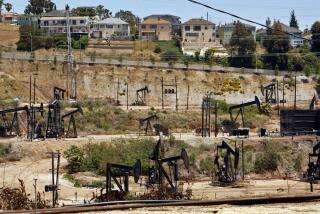‘Schwarzkopf of the Oil Firefighters’ Calls It a Once-in-a-Lifetime Feat : * Energy: Larry H. Flak led those who put out 698 blazes in Kuwait. He did the job in seven months, and he didn’t lose anyone to the mines or ammo on the ground.
- Share via
LONDON — The man who commanded what he calls Operation Desert Hell--extinguishing hundreds of oil well fires in Kuwait--estimates that the seven-month effort cost about $1.5 billion.
But the oil wasted in the burning wells was costing about $100 million a day early on, so the Kuwaiti government got something of a bargain, said Larry H. Flak, operations manager for the project.
His colleagues sometimes referred to Flak, a burly, bespectacled six-footer, as the “Gen. Schwarzkopf of the oil firefighters.”
After Norman Schwarzkopf’s troops and their allies expelled the Iraqi army from Kuwait, the oilmen took over to repair the Iraqi sabotage to the sheikdom’s oil fields. Like the allied military coalition, the oilmen accomplished their mission in a remarkably short time: The last well was capped early this month, although some experts had predicted that the operation would take up to five years.
In the well-capping campaign, Flak deployed a force of about 550 firefighters, with another 10,000 backup employees providing logistics, housing, food and transport.
Looking back on the experience during a stopover in London, the 36-year-old Flak said: “For the last year, I have had only one goal in sight: how to cap those wells. I suppose the scale of the effort is something no one will ever do again. . . . Now we have to go back to being humans again.”
Flak’s firm, OGS Associates of Houston, was hired by the Kuwaiti government 13 months ago, during the Iraqi occupation, to manage the task of putting the more than 700 wells back into operation after the expected defeat of Iraq.
But neither OGS nor anyone else suspected that the retreating Iraqis would attempt to torch every single well, leaving the skies polluted and the sands blackened.
OGS, which boasts some of the most experienced specialists in the world at capping blown-out oil wells, enlisted the help of four veteran oil firefighting firms: the Red Adair Co., Boots & Coots and Wild Well Control, all from Texas, and the Safety Boss of Calgary, Canada.
Flak, who worked as an oil field roughneck before taking a petroleum engineering degree at Texas A&M;, organized the firefighters into 27 teams at the peak of activities. Each team, with four firefighters and six to eight support personnel, was provided with three 40-ton bulldozers; a 15-ton front-end loader; a 65-ton backhoe; a 34-ton backhoe with a longer reach; an ambulance; two fire pumps, and a rest trailer.
For each team, a million-gallon, plastic-lined lagoon was dug and filled with seawater for extinguishing the blazes. As part of the procedure, a new technique was used: A laser-like, high-velocity mix of water and abrasives was shot at more than four times the speed of sound to cut off the damaged well-top, or “Christmas tree.”
“The idea then is to pump in so much water so quickly that the fire is doused,” Flak explained.
The firefighters wore lots of protection: long johns and a hood made of Nomex, a lightweight, flame-resistant material; two suits of heavy cotton on the outside; two pairs of socks, and two pairs of gloves.
“The advantage of cotton is that it is absorbent and creates a water blanket over you which can withstand the heat from the fires even though your clothing is steaming,” Flak said. “Aluminized suits are too hot and bulky, and you can’t get much work done.”
Toward the end of the operation, the Kuwaiti government invited teams from other countries, who put out perhaps 50 wells.
“I think there was a misapprehension that they arrived to beef up the operation and complete it,” Flak said. “But our original coalition capped 698 wells.”
What was the biggest surprise?
“Midnight at noon,” Flak said. “We didn’t anticipate we’d have to set up floodlights powered by generators just in order to see.”
The biggest danger?
“Once you stop the fire and you’re trying to cap the well, running in mud to plug it up, that’s the hard part. You’re soaked in oil and if the well fire re-ignites, you’re like a big wick, and you could go up in a flash.”
What was the key to success?
“Hard work from men with practical experience. At our peak in mid-October, we were capping 13 wells in a day, 52 in a week. We got real good. We emphasized safety. No one was killed by all the mines and ammo on the ground.
“It was a pressure cooker out there, and it brought out the best in the firefighters. Just like the military.”
Flak noted that the American oil coalition has saved the world’s second-largest oil field, with 50 billion barrels of reserves.
“We prevented long-term damage to the field and stopped the pollution,” he said. “The skies are clear. There are still oil lakes that we are pumping clean. And then the desert winds will just have to take over the rest.”
More to Read
Sign up for Essential California
The most important California stories and recommendations in your inbox every morning.
You may occasionally receive promotional content from the Los Angeles Times.










